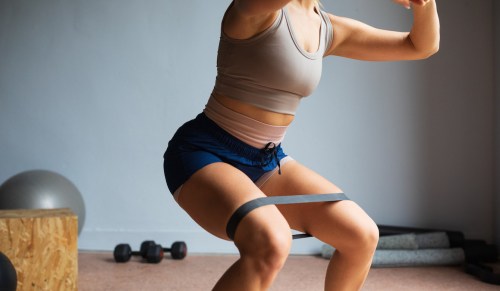You know when you’re growing out your hair and you reach that awkward period between your short style and the longer style you’re oh-so-patiently waiting for? Well, push-ups kind of work the same way. Once you’ve done enough incline push-ups that you’ve moved on to master a regular push-up, there’s a period where you’re strong… but not quite strong enough to take on harder push-up variations like the Russian push-up or the pseudo push-up. Like your hair, you still need some growing time before you reach your goal. And the best exercises for push-ups will help you get there.
Experts in This Article
fitness trainer and founder of Le Sweat
personal trainer and co-founder of New York City Personal Training
fitness trainer at Life Time Summerlin
trainer and co-founder of SWEAT
certified personal trainer for Blink Fitness
certified trainer, Pilates instructor, and founder of Brooks Pilates
Trainer Kayla Itsines shared some exercises on Instagram that help strengthen the key muscles you use when you’re doing push-ups. By doing the best exercises for push-ups, “not only will you improve your strength, but it will also improve your push-up form,” she writes. If you incorporate them into your weekly upper body sessions, you’ll become strong enough to do advanced push-up exercises like a champ. But before finding out what exercises help with push-ups, let’s take a step back and dive into the basics.
What are push-ups?
What is a push-up, exactly? “A push-up is a versatile exercise that engages your entire body, with a primary focus on strengthening the upper body,” says Sarah Brooks, certified trainer and founder of Brooks Pilates. “It involves lowering and lifting your body using your arms while maintaining core engagement.”
While push-ups are primarily thought of as an upper-body exercise, they don’t just build strength in your arms (primarily the triceps), chest, and shoulders. The movement also requires you to engage your core, which—because the core wraps around your torso—involves the obliques, back muscles, glutes, and pelvic floor, too. That’s a lot of muscles worked with a bodyweight exercise you can do anytime, anywhere—no equipment needed.
The benefits of push-ups
A next-level fitness routine doesn’t need to involve any fancy advanced strength training exercises. Something as simple as the humble push-up can bring on benefits far beyond building your upper body strength
1. They engage your full body
If you do push-ups consistently, you won’t just notice increased upper body strength—you’ll feel stronger elsewhere, too. “Push-ups offer a range of benefits, including full-body engagement that leads to increased overall strength,” says Brooks. “They are notably challenging and help target multiple muscle groups simultaneously.” (Speaking of full-body: You could even try soleus pushups, aka pushups for your calves. And you can do them while you’re sitting!)
2. They’re a sneaky core exercise
While push-ups are primarily thought of as an arm-boosting exercise, Brooks says they also promote improved core stability. If you notice that ab exercises are feeling a little easier after adding general push-ups or push-up variations to your strength-building workouts, that’s why.
3. They improve your posture
Doing push-ups regularly can help you stand a little taller. Because push-ups strengthen your back, core, and shoulders, the bodyweight exercise can “help with posture, which can help reduce the risk of injury,” Ronny Garcia, certified personal trainer for Blink Fitness, previously told Well+Good.
4. They support healthy joints and blood circulation
Another reason push-ups make for a next-level fitness routine is because the benefits go deeper than increased muscle strength. They support you internally, too. “When completed through full ranges of motion without outstanding movement imbalances, [push-ups] can help keep your lean tissue healthy, joints healthy, and help with blood circulation,” Joshua Thomas, a trainer at Life Time Summerlin, previously told Well+Good.
5. They increase bone density
As you get older, increasing muscle and bone density becomes increasingly important. According to Guy Codio, a personal trainer and co-founder of New York City Personal Training, strength training exercises like push-ups can help with that. “The denser our muscles become, the stronger our bones become,” he previously told Well+Good. See? You don’t have to do advanced bodyweight workouts to see results—even simple moves make meaningful changes.
How to perform a push-up like a pro
Before adding any advanced push-up exercises or the best push-up variations to your routine, you have to master the basics first. Learn how to perform a push-up and modified push-up with perfect form below. (But before you get started, an FYI—a small 2018 study found modified push-ups are just as effective as the real deal. So if the exercise is more comfortable on your knees, go for it.)
How to do a push-up
- 1.Start in a plank position with your hands aligned under your shoulders and your legs straight, on your toes.
- 2.Engage your core by bringing your belly button toward your spine.
- 3.Keeping a straight line from your head to your heels, lower your chest to the floor.
- 4.Right before your chest touches the floor, lift back to your starting position. Remember to inhale as you descend and exhale as you press back up.
How to do a modified push-up
- 1.Start on your hands and knees.
- 2.Keeping a straight line from the top of your head to your knees, engage your core, bend your elbows, and lower your chest toward the floor.
- 3.Right before your chest touches the floor, straighten your arms to raise your body back to the starting position. Always inhale as you descend and exhale as you press back up.
Common mistakes when doing push-ups
Push-ups seem easy enough, but trust us—they’re harder than they look. If you don’t practice proper form when doing the bodyweight exercise, you could wind up hurting yourself. “Consistently performing push-ups incorrectly can lead to shoulder injuries due to overuse and improper form,” says Brooks. Here are some common mistakes to avoid during your next strength-building workout.
1. You’re pushing your butt in the air
It’s common to cheat and lift your butt in the air as you’re doing push-ups to make them easier, but always keep your body in a straight line.
2. Your alignment is off
It’s easy to lose the correct alignment when doing push-ups—especially when you’re trying to bust out multiple in a row. Charlee Atkins, fitness trainer and founder of Le Sweat, previously told Well+Good the checklist she keeps in mind: “Shoulders are right over my wrists, my middle finger is pointing forward, and my hands are about mat width apart. I have a straight line from my head to my heels,” she says.
3. You’re jutting your head forward
The next time you do a push-up, ensure you’re not sticking your head forward as you’re lowering your body to the ground. If your face feels like it’s going to meet the floor before your chest, that’s a good sign that you need to make some adjustments.
To watch these mistakes in motion, follow along with this video:
What exercises help with push-ups? 6 options to try
To maximize your push-up performance, incorporate gradual fitness progressions—including Itsines’ best exercises for push-ups—to take your muscle power to the next level. You’ll be prepared for all the advanced strength training (and push-up challenges!) to come.
1. Plank and reach
- 1.Start in a forearm plank.
- 2.Reach your right arm straight out in front of you, then return it to your mat.
- 3.Repeat on the opposite side, alternating back and forth between arms.
2. Plank rocks
- 1.Start in a forearm plank.
- 2.Slowly rock your body forward.
- 3.Rock your body back to your starting position.
3. Plank rotation
- 1.Start in a forearm plank.
- 2.Rotate to a side plank on your right side.
- 3.Return to center then rotate to a side plank on your left side.
- 4.Continue alternating between sides in one seamless motion.
4. Push-up hold
- 1.Start in a push-up position on your knees.
- 2.Lower into a push-up, allowing your body to hover slightly above the mat.
- 3.Hold for 30 seconds. Repeat.
5. Negative push-up
- 1.Start in a push-up position on your knees.
- 2.Slowly lower your body into a push-up.
- 3.Raise back up to your starting position.
6. Toes down
- 1.Start in a high plank.
- 2.Lower your body into a push-up.
- 3.Once your face is inches above the floor, gently drop your knees to the mat.
- 4.Raise your upper body until your arms are straight.
- 5.Straighten your legs so you’re back in a high plank position.
Frequently asked questions about push-ups
Why do I struggle with push-ups?
You’re great at squats but push-ups feel like they should be part of an advanced strength training routine. What gives? “Struggling with push-ups can often be attributed to a lack of upper body and core strength, which can be developed over time with practice and focused training,” Brooks says. Like anything, practice makes perfect. Any push-up challenges can be tackled by starting with modified push-ups then working your way up to regular push-ups as your upper body strength increases.
How do I build strength for push-ups?
According to Brooks, “building strength for push-ups can be achieved by incorporating exercises that target similar muscle groups, such as the arms, abs, and back.” Aside from the exercises that help with push-ups above, you can also utilize hand weights: “Using hand weights, lift your arms up and down to shoulder height, all while keeping your abs engaged,” she says. “You can perform 15 to 20 reps with light weights or 8 to 10 reps with heavier weights.”
Is there a way to make push-ups easier?
If you want to make push-ups a little easier—but still get the same muscle-boosting benefits—simply modify them during your next strength-building workout. “Modified push-ups follow the same principles but involve performing the exercise on your knees with your feet lifted or on the ground, making them more accessible for beginners and those working on building strength,” she says. In time, if you decide to move to regular push-ups for a more advanced bodyweight workout, you’ll have laid the groundwork and will have the increased strength and proficiency to do so.
How can I take my strength to the next level with fitness progressions?
To enhance your upper body strength, consider incorporating fitness progressions into your next-level fitness routine, such as the plank push-up or weighted push-ups, as you become more proficient in standard push-ups. You can even incorporate push-up challenges into your weekly workout routine, seeing how many of these advanced push-up exercises you can do in a row.
Sign Up for Our Daily Newsletter
Get all the latest in wellness, trends, food, fitness, beauty, and more delivered right to your inbox.
Got it, you've been added to our email list.











